| Overview: |
The use of low emission diesel engines as a power supply for mobile air conditioners will reduce emissions at activities in addition to meeting 1996 federal and state standards for emissions from off-road industrial diesel engines. State standards vary from state to state. However, meeting the most stringent standards of California will result in meeting other states' emission standards. Existing mobile air conditioners will require retrofitting as they are all
currently powered by a Detroit Diesel Model 6V-71.
A study conducted for the Navy evaluated several engines on the basis of meeting emission
standards, performance specifications for the air conditioner, use of jet fuel, and the
ability to fit the present engine space envelope. The John Deere 6081A engine met
all requirements. Two other engines, manufactured by Cummins and Caterpillar, could
be considered with some modifications in engine design.
The mobile air conditioners will require some modifications to accept the new engines.
The radiator and oil cooler of the air conditioner will need to be extended
slightly outward. Because these engines are longer than the 6V-71 engine, relocation
of the engine mounts and a suitable connecting structure to distribute the load within the
base frame will also be required.
|
| Compliance
Benefit: |
The use of low emission diesel engines as a power supply for mobile air conditioners will
reduce emissions and therefore may help a facility to meet the emissions limits of an air
permit issued in accordance with 40 CFR 70 and 71 or related state requirements.
It may also decrease the need for a facility to obtain an air permit in the first place.
The compliance benefits listed here are only meant to be used as general
guidelines and are not meant to be strictly interpreted. Actual compliance benefits
will vary depending on the factors involved, e.g. the amount of workload involved.
|
| Materials Compatibility:
|
No materials compatibility issues were identified.
|
| Safety and
Health: |
Consult your local industrial health specialist and your local health and safety personnel
prior to implementing this technology.
|
| Benefits: |
- Reduction in engine exhaust emissions.
- Compliance with Federal and state emission standards.
|
| Disadvantages: |
- Existing mobile air conditioners will require modifications
to fit the new engines.
|
| Economic
Analysis: |
Labor, material, system maintenance, and energy requirements will remain the same with the
new low emission diesel power supply engine for the mobile air conditioner because the new
engine is required to provide the same performance (horsepower and torque range) as the
existing Detroit diesel engine.
The mobile air conditioner is considered a stationary source of air emissions. With
the engine retrofit, there is a reduction in air emissions and therefore a reduction in
emission fees if there is a significant number of these units at an activity. On a
per unit basis, the reduction in emission fees is insignificant. The cost savings in
emission fees when compared to the cost of the retrofit engine at approximately $40,000
will not result in a favorable payback period.
|
| NSN/MSDS: |
None identified.
|
| Approval Authority: |
Appropriate authority for making process changes should always be sought and obtained prior to procuring or implementing any of the technology identified herein.
|
| Points
of Contact: |
For more information
|
| Vendors: |
This is not meant to be a complete list, as there may be other manufacturers of this type of equipment.
John Deere
John Deere Power Systems Engines
P.O. Box 5100
3801 West Ridgeway
Waterloo, IA 50701
Phone: (319) 292-6060
or (800) 533-6446
FAX: (319) 292-5075
URL: www.johndeere.com/engines
Cummins Engine Company
Global Headquarters
500 Jackson Street
Columbus, IN 47201-6258
Phone: (812) 377-5000
FAX: (812) 377-3334
URL: www.cummins.com
|
| Related Links: |
Low-Emissions Diesel (A/M27T-5)
Low-Emissions Diesel (A/M32C-17)
Low-Emissions Diesel (NC-10C)
|
| Sources: |
Mr. Al Telcak, SEMCOR, Inc., May 30, 1996.
Mr. Phil Norton, Keco Industries, June 14, 1996.
San Diego County Air Pollution Control District Rules and Regulations. Rule 69.4 -
Stationary Reciprocating Internal Combustion Engines.
|
| Supplemental: |
Picture of Low-Emissions Diesel (A/M32C-17)

|

